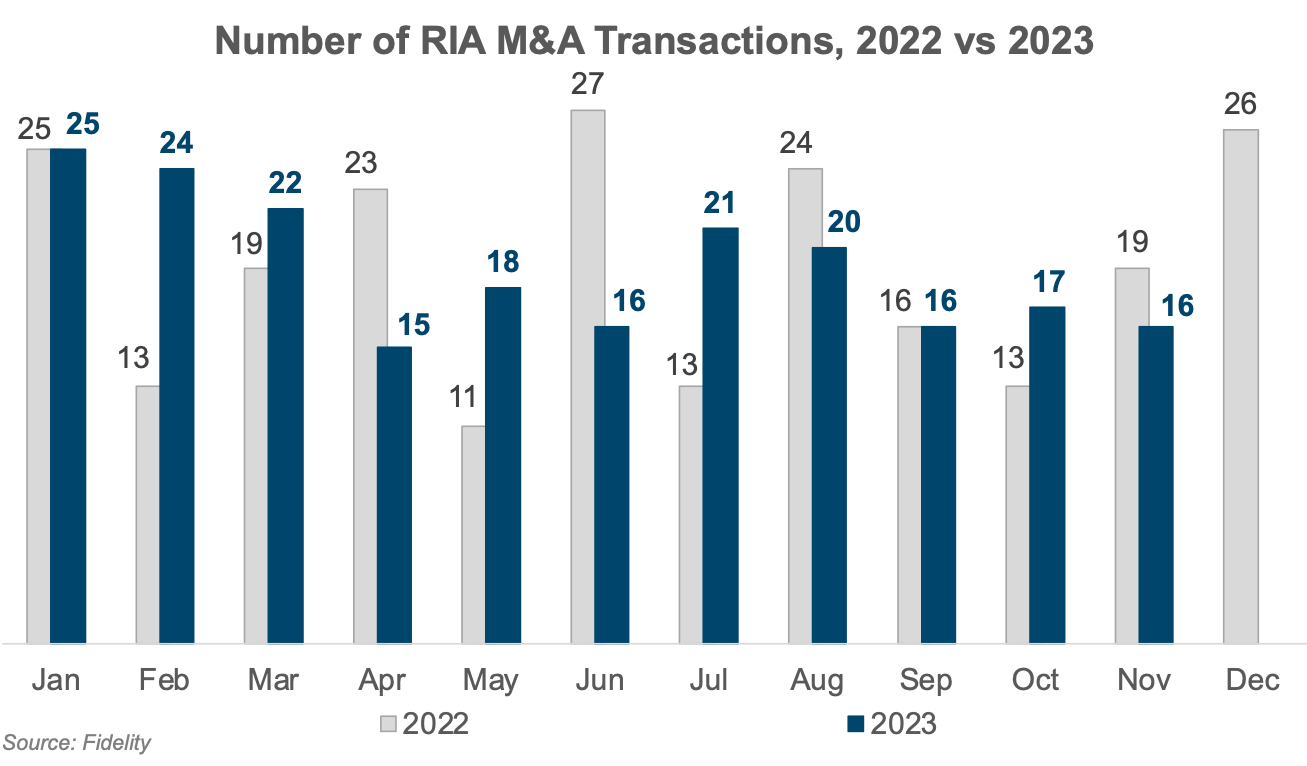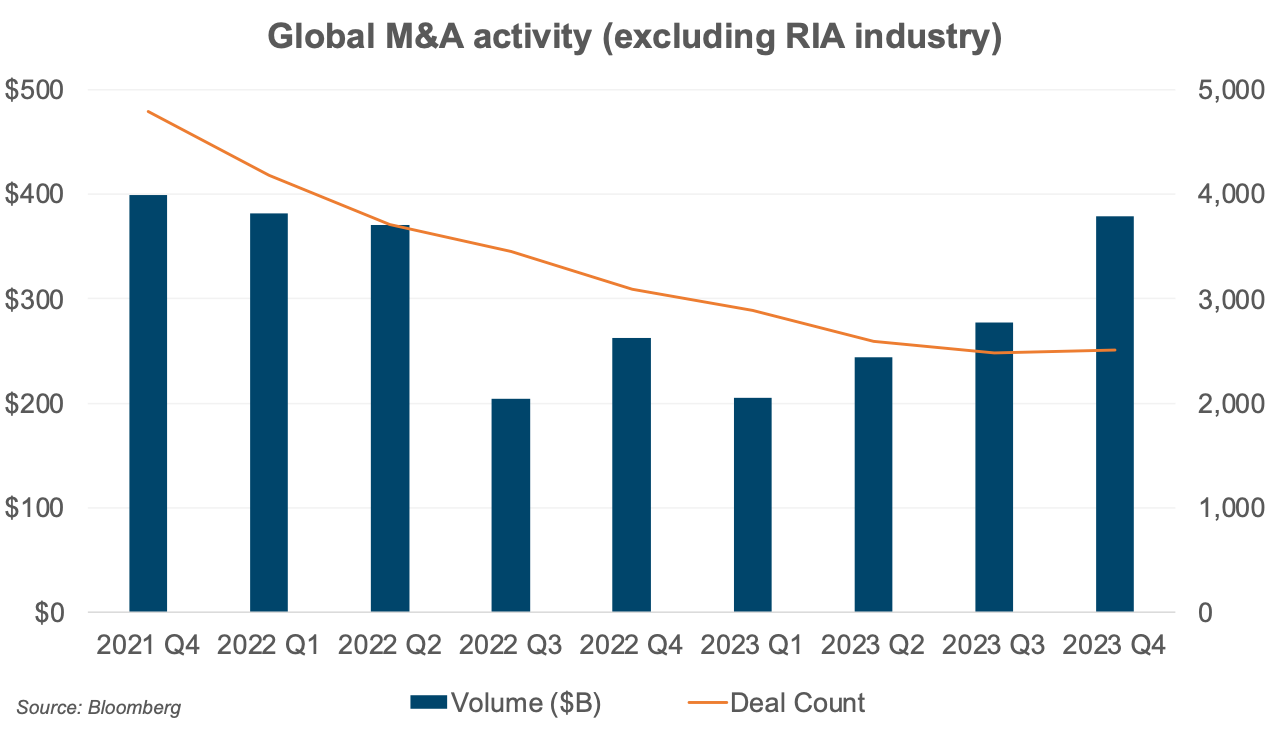The Remarkable Resilience of RIA M&A Activity
RIA M&A activity has demonstrated remarkable resilience, defying initial expectations of a slowdown amid challenging macroeconomic conditions. As the economy entered 2023 facing high inflation, rising interest rates, and tight labor markets, many anticipated a decline in M&A activity. However, Fidelity’s November 2023 Wealth Management M&A Transaction Report listed 210 deals through November 2023, up 3% from the 203 deals executed during the same period in 2022. Notably, there was a significant uptick in total transacted AUM during 2023. Total transacted AUM through November 2023 was $336.6 billion—a 25% increase from the same period in 2022.
While deal volume for 2023 has been roughly in line with 2022 levels, there was a notable slowdown during the second quarter of 2023 as total transactions fell approximately 20%. Deal volume recovered in the second half of the year, with 90 deals from July to November, representing a 6% year-over-year increase in deal count. Per Echelon Partners’ recent report, “We attribute this increase to the continued influence of fundamental forces driving consolidation in the industry and to buyers and sellers gaining greater confidence in the macroeconomic environment.”

Relative to the broader M&A market, RIA deal activity has been exceptionally robust. The overall M&A transaction value for all industries (excluding the RIA industry) decreased 9% year-over-year through the fourth quarter of 2023 (per Bloomberg).

In contrast, RIAs’ total transacted AUM (a proxy for transaction value) increased by 25%. The average AUM per transaction during 2023 was $1.6 billion, a 21% increase over the prior year. The increase in deal size has been an encouraging sign, given the rise in the cost of capital over the past year. Echelon’s RIA M&A Deal report stated that the growth in deal size can primarily be attributable to “an increase in equity markets and the consistent deployment of newly raised capital by firms like Mercer Advisors, Corient, HUB International, and CAPTRUST. Echelon estimates that large wealth platforms raised an incremental ~$7.2 billion to pay down debt, increase war chests for acquisitions, and invest in growth.”
Another contributor to the increase in deal size has been RIAs partnering with private equity firms. According to Fidelity’s November 2023 Wealth Management M&A Transaction Report, private equity backing was involved in 94% of the transactions in November. Private equity acquirers directly invested in wealth managers with assets totaling $877 billion in the third quarter of 2023, more than tripling the amount in the second quarter of 2023 (per Echelon’s Q3 2023 RIA M&A Deal Report). This increase was due to some of the largest wealth management consolidators taking on new private equity partners. Notable transactions of this nature include CAPTRUST, which sold an undisclosed stake in its wealth management business to Carlyle Group; Prime Capital Investment Advisors, who received a minority investment from Abry Partners; and Titan Wealth Holdings, who sold an interest in its business to Parthenon Capital.
The prevalence of serial acquirers and aggregators has continued in the RIA M&A market. In recent years, the professionalization of the buyer market and the entrance of outside capital have driven demand and increased competition for deals. Serial acquirers and aggregators have increasingly contributed to deal volume, supported by dedicated deal teams and access to capital. Such firms accounted for approximately 68% of transactions during 2023. Waverly Advisors, Wealth Enhancement Group, and Focus Financial Partners all completed multiple deals during the fourth quarter.
Deal activity has also been supported by the supply side of the M&A equation, as the impetus to sell is often based on more than market timing. Sellers are often looking to solve succession issues, improve quality of life, and access organic growth strategies. Such deal rationales are not sensitive to the market environment and will likely continue to fuel the M&A pipeline even during market downturns.
What Does This Mean for Your RIA?
For RIAs planning to grow through strategic acquisitions: Pricing for RIAs has trended upwards in recent years, leaving you more exposed to underperformance. While the impact of current macro conditions on RIA deal volume and multiples remains to be fully seen, structural developments in the industry and the proliferation of capital availability and acquirer models will likely continue to support higher multiples than the industry has seen in the past. That said, a long-term investment horizon is the greatest hedge against valuation risks. Short-term volatility aside, RIAs continue to be the ultimate growth and yield strategy for strategic buyers looking to grow their practice or investors capable of long-term holding periods. RIAs will likely continue to benefit from higher profitability and growth than their broker-dealer counterparts and other diversified financial institutions.
For RIAs considering internal transactions: We’re often engaged to address valuation issues in internal transaction scenarios, where valuation considerations are top of mind. Internal transactions don’t occur in a vacuum, and the same factors driving consolidation and M&A activity have influenced valuations in internal transactions as well. As valuations have increased, financing in internal transactions has become a crucial secondary consideration where buyers (usually next-gen management) lack the ability or willingness to purchase a substantial portion of the business outright. As the RIA industry has grown, so too has the number of external capital providers who will finance internal transactions. A seller-financed note has traditionally been one of the primary ways to transition ownership to the next generation of owners (and, in some instances, may still be the best option). Still, an increasing amount of bank financing and other external capital options can provide selling partners with more immediate liquidity and potentially offer the next-gen cheaper financing costs.
If you are an RIA considering selling: Whatever the market conditions are when you go to sell, it is essential to have a clear vision of your firm, its value, and what kind of partner you want before you go to market. As the RIA industry has grown, a broad spectrum of buyer profiles has emerged to accommodate different seller motivations and allow for varying levels of autonomy post-transaction. A strategic buyer will likely be interested in acquiring a controlling position in your firm and integrating a significant portion of the business to create scale. At the other end of the spectrum, a sale to a patient capital provider can allow your firm to retain its independence and continue operating with minimal outside interference. Given the wide range of buyer models out there, picking the right buyer type to align with your goals and motivations is a critical decision that can significantly impact personal and career satisfaction after the transaction closes.
About Mercer Capital
We are a valuation firm that is organized according to industry specialization. Our Investment Management Team provides valuation, transaction, litigation, and consulting services to a client base consisting of asset managers, wealth managers, independent trust companies, broker-dealers, PE firms and alternative managers, and related investment consultancies.
 RIA Valuation Insights
RIA Valuation Insights 






